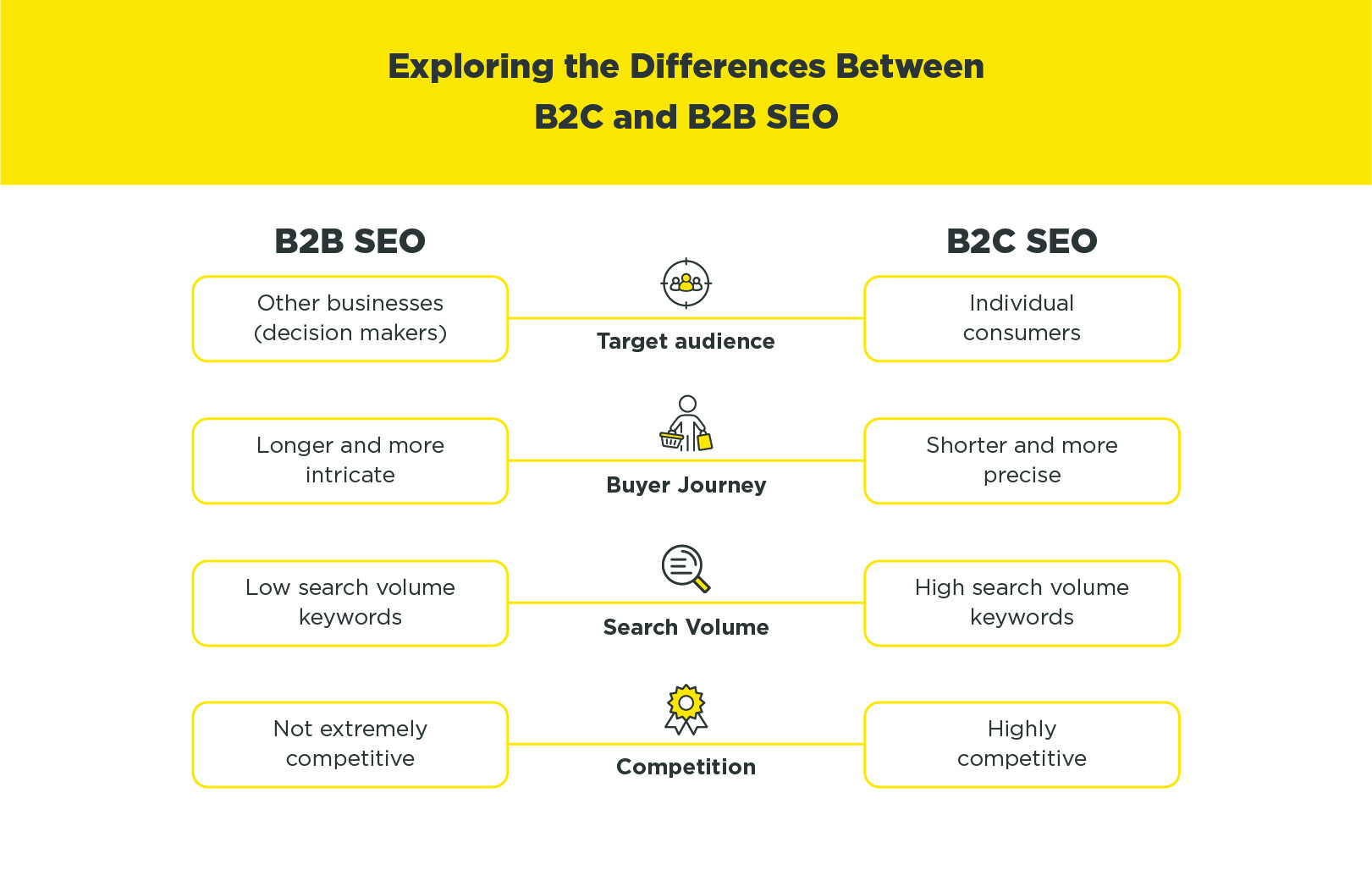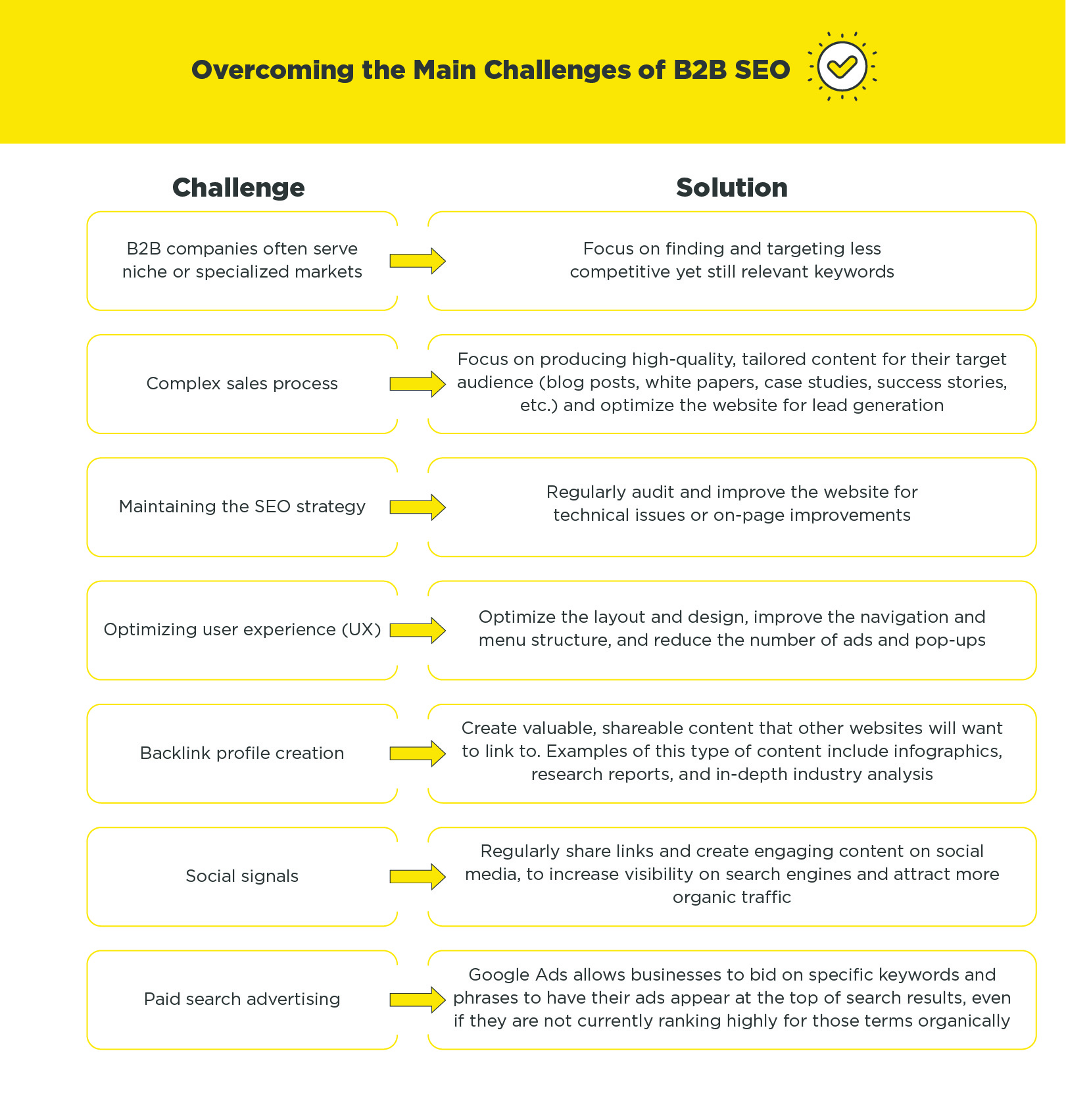2023 B2B SEO Guide: Navigating Challenges and Developing a Successful B2B Strategy for Your Business

Search engine optimization (SEO) is the process of improving the ranking of a website on search engines like Google with the aim of increasing the visibility and organic traffic to the site. This is particularly important for B2B companies, as it can be difficult to stand out in a crowded and competitive market.
Based on our experience, a large portion of organic traffic for B2B companies comes from branded searches. With SEO, the goal is to broaden the reach and exposure of the website by ranking it for additional relevant, generic keywords. However, we have worked with a diverse clientele and have found that this is not always straightforward, particularly because the target audience in B2B businesses tends to behave differently than that of B2C businesses.
To capture the most prominent keywords, we must focus on high-intent keywords that may be searched by people within the target companies. This can be a challenge, but in this article, we will discuss some of the unique challenges that B2B businesses face with SEO and provide some best practices and ideas for overcoming them. By doing so, we hope to improve the SEO strategy and increase organic traffic with the potential to convert to paying customers.
Exploring the Differences Between B2C and B2B SEO
B2B (business-to-business) and B2C (business-to-consumer) companies often have different SEO strategies because their target audiences, goals, and buying processes are usually distinct. This is especially true when it comes to optimizing for search engines.
1. Target audience:
The target audience is a key difference between B2B and B2C companies when it comes to SEO. B2B companies typically target other businesses, while B2C companies target individual consumers. This means that the keywords and phrases used in B2B SEO may be more technical and specialized, while B2C SEO may focus on more general and consumer-oriented terms.
For example, a B2B company like Asana or Monday might create content around its product and its benefits, such as how to increase team productivity by using a project management tool and provide useful tips and resources like a holiday content calendar template.
On the other hand, a B2C company like a real estate company might focus on its different products and services and create content about them, using more general and consumer-oriented keywords like “top real estate in the US.”
2. Buyer journey:
In comparison to B2C products, the purchasing process for B2B products and services tends to be longer and more intricate. As a result, B2B firms may have to develop more comprehensive, informative content to assist potential buyers in comprehending the advantages and characteristics of their offerings. For instance, B2B companies can create videos that demonstrate how the tool functions and other resources that provide an overview of the various features.
3. Search volume:
In comparison to B2C keywords, B2B keywords often have lower search volume and conversion rates due to the typically more thorough and well-planned decision-making process for B2B purchases. As a result, B2B SEO strategies may prioritize attracting and converting highly qualified leads rather than just increasing traffic. While the conversion rates for B2B SEO may be lower than those for B2C SEO, the value of each conversion is often higher.
4. Competition:
B2B keywords may not be as competitive as B2C keywords due to fewer companies vying for the same audience. However, it’s still possible to see your main competitors ranking for your important keywords. The main distinction between B2B and B2C SEO lies in the focus on the target audience and the goals of the company.
To optimize your SEO strategy and create content that effectively attracts and converts leads, it’s essential to understand the needs and preferences of your target audience.
What are the Top Challenges in B2B SEO?
1. Identifying target keywords:
Complex products or services offered by B2B companies can be difficult to explain in layman’s terms. It can be a challenge to determine the specific keywords that potential customers might use to search for these products or services. For example, a cloud computing company may need to research and understand what their target audience is searching for, such as topics like distributed systems in cloud computing, object storage, or cloud-native architecture.
2. Competition:
In B2B markets, there may be many companies trying to rank for the same keywords, which can make it challenging to achieve a high position in search results. While B2B may not be as competitive as B2C, a B2B business will still need to compete with a smaller number of competitors in a more specific industry niche.
3. Long sales cycle:
The decision-making process for B2B sales tends to be longer than in B2C sales. As a result, it may take more time for SEO efforts to be successful in generating leads and conversions. This is because it may take longer for potential B2B customers to become aware of a business and consider making a purchase or providing their contact information.
4. Limited resources:
B2B companies, especially small or medium-sized businesses, may have limited resources for SEO strategies. This can make it challenging to compete with larger, more established companies that have more resources for SEO. For example, small B2B businesses may not have an in-house content writer to create guides, which can make it harder for them to produce that type of content.
5. Technical challenges:
B2B websites can be difficult to optimize for search engines due to their complex structures and the need for specialized technical SEO knowledge. This can be a problem for businesses without in-house SEO expertise or the budget to hire a specialist.
Additionally, websites built with React or other JavaScript technologies may also face difficulties being crawled or indexed by Google. However, proper HTML integration can resolve this issue. It is important to ensure that a website is crawlable before investing in SEO efforts to ensure that the effort is not wasted.
Overcoming the Main Challenges of B2B SEO: Best Practices
- One of the primary difficulties that B2B companies encounter with search engine optimization is the fact that they often serve niche or specialized markets. This means that the keywords and phrases used by potential customers may be more specialized and less frequently searched than in the B2C space. Consequently, it can be harder for B2B businesses to rank highly on search engines for these more specific keywords. Another challenge in the realm of SEO for B2B companies is competition.
To address this issue, B2B companies should focus on finding and targeting less competitive yet still relevant keywords. This can involve conducting keyword research to discover long-tail keywords with a lower search volume but higher relevance to the products or services being offered.
For example, instead of targeting the broad keyword “project management”, a B2B business might target the more specific long-tail keyword “project management software for engineering firms.” Long-tail keywords can be more effective at bringing in targeted traffic to a website because they are more precise and relevant to the products or services being offered
- Another challenge that B2B companies encounter with SEO is that they frequently have a more complex sales process than B2C businesses, which can make it harder to generate leads and conversions from organic traffic.
To address this challenge, B2B companies should focus on producing high-quality, tailored content for their target audience. This can include blog posts, white papers, case studies, success stories, and other types of educational materials that help establish the business as a thought leader in its industry and boost its visibility on search engines.
In addition to developing a comprehensive B2B SEO content strategy, businesses should also optimize their website for lead generation. This can involve adding forms and calls to action (CTAs) to important pages on the site, such as product pages or blog posts, to capture the contact information of potential customers. B2B businesses may also want to consider integrating their website with their customer relationship management (CRM) system in order to track and manage leads more efficiently
- B2B companies often struggle with maintaining their SEO strategy due to the constantly changing algorithms and recommendations from search engines like Google.
To address this issue, it is important for these businesses to regularly audit and improve their website. This can involve optimizing elements such as page titles, meta descriptions, site speed, and mobile-friendliness in order to both satisfy search engines and provide a better user experience.
- Another important challenge of SEO for B2B businesses is user experience (UX). Search engines like Google use a variety of factors to determine the quality and relevance of a website, and one of these factors is the UX of the site.
To create a successful website for a B2B business, it is important to ensure that the site is easy to navigate, loads quickly, and provides a pleasant user experience. This may involve optimizing the layout and design, improving the navigation and menu structure, and reducing the number of ads and pop-ups. A helpful tip is to make sure the most important content is visible without the user having to scroll down.
- Backlink profile creation: It’s important for B2B companies to put effort into acquiring backlinks for their website. These are links from external sites that point to a page on your site. Search engines take backlinks into account when ranking websites, so they can boost your visibility and credibility.
To get high-quality backlinks, B2B businesses should focus on creating valuable, shareable content that other websites will want to link to. Examples of this type of content include infographics, research reports, and in-depth industry analysis.
- Social signals: B2B companies should also consider using social media to enhance their search engine optimization (SEO) efforts. Platforms like LinkedIn, Twitter, and Facebook can be effective for driving traffic and engagement to a website.
By regularly sharing links to their site and creating engaging content on social media, B2B businesses can increase their visibility on search engines and attract more organic traffic. Tip: take into consideration that acquiring strong social singles may require investing additional paid resources in order to promote your social activities using different social paid platforms (Facebook, LinkedIn, Tiktok ads, etc.)
- In addition to SEO, B2B companies should also consider using paid search advertising to boost their online presence.
For example, Google Ads allows businesses to bid on specific keywords and phrases to have their ads appear at the top of search results, even if they are not currently ranking highly for those terms organically.
While paid search advertising can be an effective way to attract traffic to a website, it is important for B2B businesses to carefully manage their budget and target their ads to the most relevant keywords and phrases.
One tip for B2B companies is to open a brand campaign for “Brand protection” to ensure that their ad appears at the top of the search engine results page (SERP) even if competitors are bidding on their brand name. This strategy can also be useful for new companies with generic names that bring up a variety of unrelated results.
Creating B2B Content that Converts to Leads
Now that you have a good understanding of the common challenges faced in creating B2B content and how to overcome them, let’s delve deeper into the process of creating content that effectively converts your users. To create B2B content that generates leads, it is necessary to implement a combination of different strategies and tactics. Here are a few steps you can follow to create successful B2B content:
- Identify your target audience: Determine the specific group of people you want to reach with your content by understanding their needs, challenges, and goals.
- Select a compelling topic: Choose a topic that is relevant to your target audience and addresses a specific problem or challenge they face.
- Create high-quality content: Utilize various formats, such as blog posts, ebooks, webinars, PR, and infographics, to provide valuable information and insights to your audience. Make sure your content is thorough, long enough, and covers the entire topic.
- Tip: Don’t forget to include links to and from other pages to improve their discoverability in Google.
- Optimize your content for search engines: Utilize keywords and phrases that your target audience is likely to search for, and ensure that your content is well-written and easy to read (e.g., keep sentences short and understandable, include main keywords in metadata, H1 title, and subtitles).
- Promote your content: Share your content on social media, email lists, and other channels to reach a wider audience and drive traffic to your website.
- Include calls to action: Encourage your readers to take a specific action, such as signing up for a newsletter or scheduling a consultation, to turn them into leads.
- Tip: Make sure to add calls to action throughout the article, not just at the bottom, as some readers may not make it to the end of the post.
By following these steps, you can create B2B content that engages and converts your target audience effectively.
B2B SEO – The Bottom Line
In conclusion, SEO can be a complex and challenging task for B2B businesses, but it is also a crucial element of any online marketing strategy. By starting the SEO process with a solid understanding of the challenges and best practices, you will be able to set more realistic goals and assess your progress and success more accurately.
Developing a well-crafted B2B SEO strategy is vital to the success of your business in this field. By following the best practices outlined above, you can give yourself an edge over your competitors. Consider enlisting the help of your marketing or tech team, or using external B2B SEO services, to begin optimizing your website. Create content that is relevant to your product and target audience, and work to increase your online presence and overall authority.
If you would like to learn more about B2B SEO, our team of yellowHEAD SEO experts would be happy to assist you.




















